Get This Report about Reclaim Waste
Get This Report about Reclaim Waste
Blog Article
Reclaim Waste - The Facts
Table of ContentsThe Definitive Guide to Reclaim WasteGet This Report on Reclaim WasteThe Single Strategy To Use For Reclaim WasteReclaim Waste Things To Know Before You BuyThe 45-Second Trick For Reclaim Waste
Domestic sewage waste refers to the waste and items from a property septic container. The correct monitoring and disposal of residential sewer waste require liquid waste to be moved to a sewage therapy plant where the proper techniques and devices are used to detoxify and dispose of waste.
Industrial waste typically consists of possible threats, such as flammable products or a combination of fluid and solid waste items, and requires an advanced and in-depth disposal procedure. The disposal of commercial waste commonly entails the purification of waste before transport to make certain safe and proper disposal. Industrial waste is produced from by-products and overflow of commercial processes and production.
This kind of waste can not use the very same sewer administration transportation or procedures as septic or commercial fluids. The industrial waste administration process calls for the inspection and testing of fluid waste before it undertakes the disposal process (liquid waste removal melbourne). Runoff waste is the fluid waste that originates from drainage and excess stormwater in highly inhabited areas or cities
Runoff waste can trigger contamination and flooding otherwise managed properly. Find out more regarding sewer cleaning and waste monitoring. Making sure appropriate waste management can stop catastrophes and reduce ecological harm. Both people in household settings and experts in commercial or manufacturing sectors can gain from comprehending the processes and laws of liquid waste administration.
Reclaim Waste Fundamentals Explained
Contact PROS Services today to discover regarding our waste management and disposal services and the proper methods to take care of the liquid waste you generate.
(https://medium.com/@leonaube33101/about)This so-called 'wastewater' is not just a crucial resource yet, after treatment, will certainly be launched to our land, rivers or the ocean. Used water from commodes, showers, baths, kitchen sinks, washings and industrial processes is understood as wastewater.

water made use of to cool machinery or tidy plant and devices). Stormwater, a type of wastewater, is overflow that moves from farming and metropolitan locations such as roof Read Full Article coverings, parks, yards, roadways, courses and gutters into stormwater drains, after rain. Stormwater flows neglected directly to neighborhood creeks or rivers, at some point reaching the ocean.
See This Report about Reclaim Waste
In Queensland, the majority of wastewater is treated at sewage therapy plants. Wastewater is moved from domestic or industrial websites with a system of sewage systems and pump terminals, understood as sewage reticulation, to a sewer therapy plant.
The Division of Natural Resources encourages city governments concerning handling, operating and maintaining sewerage systems and therapy plants. In unsewered areas, local federal governments may call for householders to set up private or household sewer treatment systems to deal with residential wastewater from commodes, kitchens, restrooms and laundries. The Department of Natural Resources authorizes making use of household systems when they are proven to be reliable.
Many stormwater receives no treatment. In some brand-new class, therapy of some stormwater to get rid of clutter, sand and gravel has actually begun utilizing gross pollutant traps. Wastewater treatment takes place in 4 phases: Eliminates solid issue. Bigger solids, such as plastics and other objects mistakenly released to sewage systems, are removed when wastewater is gone through displays.
Wastewater after that moves right into big storage tanks where solids clear up and are gotten rid of as sludge. Grease and scum are skimmed from the surface area. Utilizes tiny living organisms understands as micro-organisms to damage down and remove remaining liquified wastes and great fragments. Micro-organisms and wastes are included in the sludge. Gets rid of nitrogen and phosphorus nutrients that could cause algal blossoms in our waterways and intimidate aquatic life.
Reclaim Waste - An Overview
Nutrient elimination is not readily available at all sewer treatment plants because it calls for expensive specialist equipment. Clear fluid effluent produced after treatment might still contain disease-causing micro-organisms - liquid waste disposal.

This generally suggests wastewater needs to be treated or pollutants eliminated prior to it can be released to waterways. A lot of wastewater flows right into the sewage system. Under the Act, regional federal governments carry out approvals and licences for eco appropriate tasks (Ages) including wastewater launches that could have a regional impact. The department provides approvals and permits to Ages including wastewater launches that may have a local or statewide impact.
The Greatest Guide To Reclaim Waste
Surveillance offers factual details regarding water quality and can validate that permit conditions are being satisfied. The details gotten via tracking offers the basis for making water quality choices.
Report this page